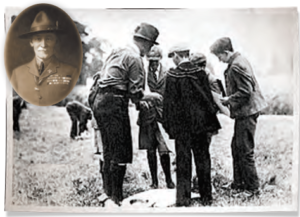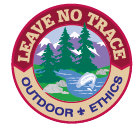Backcountry visitors have a responsibility to safeguard the land. Incorporate Leave No Trace principles into your activities.
1. Plan ahead and prepare. Proper trip planning and preparation help hikers and campers accomplish trip goals safely and enjoyably while minimizing damage to natural and cultural resources. Campers who plan ahead can minimize their impact by following area regulations such as observing limitations on group size. Schedule your trek to avoid times of high use. Obtain permits or permission to use the area for your trek. Proper planning helps ensure:
- Low-risk adventures because campers obtained sufficient information to prepare for a safe visit
- Properly sized and located campsites because enough time was allotted to reach the destination
- Appropriate campfires and minimal trash because of careful meal planning and food repackaging
- Comfortable and fun camping and hiking experiences because the outing matches the skill level of participants.
2. Travel and camp on durable surfaces. Damage to land occurs when visitors repeatedly trample vegetation and soils off-trail or near campsites. This can create undesirable informal trails, expand campsites, or erode soils.
Should you concentrate activity or spread out? In high-use areas, campers should concentrate their activities where vegetation is already absent. Minimize resource damage by using existing formal trails and selecting designated or existing campsites. Keep campsites small by arranging tents in close proximity.
In more remote, less-traveled areas, campers should generally spread out and disperse trampling. Avoid creating new trails, which can cause erosion. When camping, disperse tents and cooking activities—and move camp daily to avoid creating permanent campsites. Avoid places where impacts are just beginning to show. Choose the most durable surfaces available: rock, gravel, sand, compacted soil, dry grasses, or snow. Practices vary by environment and activity, so learn and apply the ones most applicable to Leave No Trace for your group. Check with land managers for more specific guidance.
3. Dispose of waste properly. (Pack It In, Pack It Out). Inspect and clean your lunch site or campsite of trash and spilled foods and carry them out. Accept the challenge of packing out all trash and leftover food, including any left by others.
Use toilets when available, or be prepared to dig a cathole 6 to 8 inches deep and at least 200 feet (80 steps) from water, campsites, and trails. Cover and disguise the cathole with dead leaves, pine needles, or other ground cover. Pack out all hygiene products. Walk at least 100 feet (40 steps) away from water sources and campsites to dispose of urine, toothpaste, cooking water, and strained dishwater and to wash bodies, dishes, or clothing. (Dispose of soapy water at least 200 feet away.) Minimize the use of soap, or use hand sanitizer.

4. Leave what you find. Allow others a sense of discovery and preserve the past. Leave rocks, plants, animals, archaeological artifacts, and other objects as you find them. Examine but do not touch cultural or historical structures and artifacts. It’s illegal to damage or remove artifacts.
 Minimize site alterations—good campsites are found, not made. Do not dig tent trenches or build lean-tos, tables, or chairs. Refrain from
Minimize site alterations—good campsites are found, not made. Do not dig tent trenches or build lean-tos, tables, or chairs. Refrain from
damaging trees with nails, axes, saws, or knives. On established campsites, dismantle user-built structures such as log seats or tables. On dispersed “pristine” sites, camouflage the site with rocks, organic litter, and branches to discourage others from reusing it.
5. Minimize campfire impacts. Some people would not think of camping without a campfire. Yet nature in many areas has been degraded by overuse of fires and increasing demand for firewood. Lightweight camp stoves make low-impact camping possible by encouraging a shift away from fires. Stoves are fast, eliminate the need for firewood, and make cleanup after meals easier. After dinner, enjoy a candle lantern instead of a fire. Choose not to have a fire in areas where wood is scarce at higher elevations, in heavily used areas with limited wood, or in desert settings. If you build a fire, use an existing campfire ring, and conserve wood for others by keeping it small and burning it for a short time.
Collect only dead and downed wood no bigger than your wrist that can be broken by hand. Refrain from burning trash or food, as these attract wildlife and can produce toxic fumes and ashes. When possible, burn all wood to ash, and be certain all wood and crushed coals are wet and dead out before cleaning the fire pit of trash and scattering the coals and ashes in offsite areas. Don’t forget to clean out the fire ring of debris (paper, foil, etc.), which should be packed out with the rest of your trash.
6. Respect wildlife. Quick movements and loud noises are stressful to animals. You are too close if an animal alters its normal activities. Considerate campers:
- Observe wildlife from a distance to avoid disturbing it.
- Store food securely and keep all garbage and food scraps away from animals so they will not acquire bad habits. Never feed
wildlife; keep wildlife wild. - In bear country, store all food, trash, and scented articles out of reach of animals using approved food storage devices, or hang 12 feet from the ground and 6 feet out from a limb or trunk.
7. Be considerate of other visitors. Thoughtful campers respect other visitors and protect the quality of their experience.
- Travel and camp in small groups (no more than the group size prescribed by land managers).
- Let nature’s sounds prevail. Keep the noise down and leave radios, electronic devices, and pets at home. Select campsites away from other groups to help preserve their solitude.
- Always travel and camp quietly to avoid disturbing other visitors.
- Avoid “taking over” vistas, attraction features, or camping areas; inconsiderate behaviors degrade the experiences of other visitors.
- Respect private property and leave gates (open or closed) as they were found.
- Take breaks off-trail on durable surfaces.

